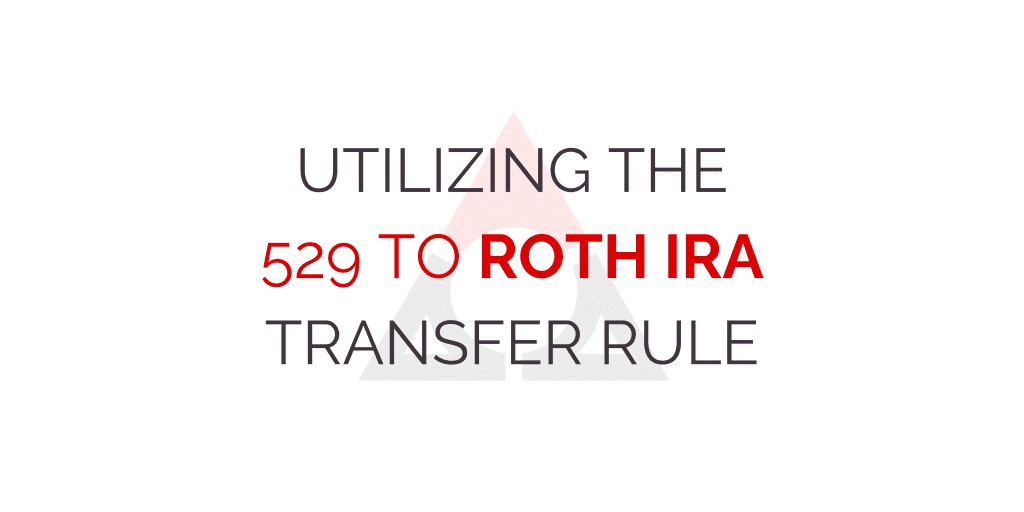With the recent passage of the Secure Act 2.0 came a new strategy for those that have an overfunded 529 plan – the ability to roll 529 funds to a Roth IRA. In this post, we will review the “Transfer of Excess 529 Funds to a Roth IRA” rule as well as the requirements that anyone pursuing this strategy will want to be aware of.
Requirements to Complete a 529 to Roth IRA Transfer
The ability to complete a 529 to Roth IRA rollover will become effective starting in 2024 and will be subject to a lifetime limitation of $35,000. The funds that are transferred will be considered a contribution and therefore subject to applicable contribution limits (currently $6,500 per year if under 50.
In order to make a contribution, the 529 account beneficiary must also be the Roth IRA owner and must have earned income to support the contribution, but transfers are not subject to income limits or phase-out restrictions. This means that the 529 beneficiary could add to their Roth IRA if they are over the income cap to contribute.
For a 529 plan to be eligible, the plan must have been established for at least 15 years and no funds (or their associated earnings) that were contributed in the last 5 years can be used. Funds will be treated on a first in, first out (FiFo) basis for this calculation.
It is unclear whether a change of beneficiary would restart the 15-year clock. While many experts believe this would not restart the clock, as the intention of the rule is to allow parents with overfunded 529’s to repurpose those savings for retirement, it is likely that new legislation will need to be passed to clarify this point.
Strategies to Utilize the 529 to Roth IRA Transfer Rule
There are two prevailing strategies that can potentially be utilized for those who find themselves with an overfunded 529 plan. Assuming legislation is passed confirming that a change of beneficiary would not restart the 15-year clock, the most common strategy would be for a parent to change the beneficiary on a 529 plan to themselves once a child has completed school and then begin to make Roth IRA transfers with the funds until the account is depleted, or the $35,000 limit is hit.
This strategy is particularly beneficial for those that make too much money to contribute directly to a Roth IRA and are unable to complete a backdoor Roth contribution. Since the transfer is not subject to income caps, this would allow them to make contributions that they would be otherwise ineligible to make.
Alternatively, if the parent’s retirement accounts are adequately funded, they could instead give their children a jumpstart to retirement by beginning to fund Roth IRA’s as soon as the 15 year establishment rule has been met. In order to make contributions, the child will need earned income to support any amount that is contributed up to the contribution limit for that year.
Business owners can pair this strategy with that of adding their child to the payroll. The child must complete legitimate work to receive compensation but could be paid an amount greater than that years Roth IRA contribution limit for work completed and then transfer the maximum amount from that child’s 529 to their Roth IRA.
If you’d like to have an introductory call to discuss your situation with our team click here to schedule a call.
If you’d like to sign-up for our monthly newsletter with four high-quality, financial planning-focused posts per month, click here.
Disclosure: The foregoing information has been obtained from sources considered to be reliable, but we do not guarantee that it is accurate or complete, it is not a statement of all available data necessary for making an investment decision, and it does not constitute a recommendation. Any opinions are those of author and not necessarily those of Raymond James. Please note, changes in tax laws may occur at any time and could have a substantial impact upon each person’s situation. While we are familiar with the tax provisions of the issues presented herein, as Financial Advisors of RJFS, we do not offer advice on tax or legal matters. You should discuss tax or legal matters with the appropriate professional.
Investors should carefully consider the investment objectives, risks, charges and expenses associated with 529 college savings plans before investing. More information about 529 college savings plans is available in the issuer’s official statement, and should be read carefully before investing.
As with other investments, there are generally fees and expenses associated with participation in a 529 plan. There is also a risk that these plans may lose money or not perform well enough to cover college costs as anticipated. Most states offer their own 529 programs, which may provide advantages and benefits exclusively for their residents. Investors should consider, before investing, whether the investor’s or the designated beneficiary’s home state offers any tax or other benefits that are only available for investment in such state’s 529 college savings plan. Such benefits include financial aid, scholarship funds, and protection from creditors. The tax implications can vary significantly from state to state.
Investing involves risk and you may incur a profit or loss regardless of strategy selected.




